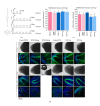Planarians sense simulated microgravity and hypergravity
- PMID: 25309918
- PMCID: PMC4182696
- DOI: 10.1155/2014/679672
Planarians sense simulated microgravity and hypergravity
Abstract
Planarians are flatworms, which belong to the phylum Platyhelminthes. They have been a classical subject of study due to their amazing regenerative ability, which relies on the existence of adult totipotent stem cells. Nowadays they are an emerging model system in the field of developmental, regenerative, and stem cell biology. In this study we analyze the effect of a simulated microgravity and a hypergravity environment during the process of planarian regeneration and embryogenesis. We demonstrate that simulated microgravity by means of the random positioning machine (RPM) set at a speed of 60 °/s but not at 10 °/s produces the dead of planarians. Under hypergravity of 3 g and 4 g in a large diameter centrifuge (LDC) planarians can regenerate missing tissues, although a decrease in the proliferation rate is observed. Under 8 g hypergravity small planarian fragments are not able to regenerate. Moreover, we found an effect of gravity alterations in the rate of planarian scission, which is its asexual mode of reproduction. No apparent effects of altered gravity were found during the embryonic development.
Figures






References
-
- Saló E, Baguñà J. Regeneration in planarians and other worms: new findings, new tools and new perspectives. Journal of Experimental Zoology. 2002;292(6):528–539. - PubMed
-
- Reddien PW, Alvarado S. Fundamentals of planarian regeneration. Annual Review of Cell and Developmental Biology. 2004;20:725–757. - PubMed
-
- Saló E. The power of regeneration and the stem-cell kingdom: freshwater planarians (Platyhelminthes) BioEssays. 2006;28(5):546–559. - PubMed
-
- Alvarado AS. Planarian regeneration: its end is its beginning. Cell. 2006;124(2):241–245. - PubMed
-
- Handberg-Thorsager M, Fernandez E, Saló E. Stem cells and regeneration in planarians. Frontiers in Bioscience. 2008;13(16):6374–6394. - PubMed
Publication types
MeSH terms
LinkOut - more resources
Full Text Sources
Other Literature Sources
Miscellaneous

